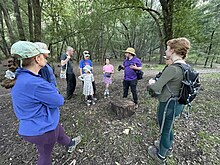City Nature Challenge

The City Nature Challenge is an annual, global, community science competition to document urban biodiversity. The challenge is a bioblitz that engages residents and visitors to find and document plants, animals, and other organisms living in urban areas.[1][2] The goals are to engage the public in the collection of biodiversity data, with three awards each year for the cities that make the most observations, find the most species, and engage the most people.[1][3][4]
Participants primarily use the iNaturalist app and website to document their observations, though some areas use other platforms, such as Natusfera in Spain.[5] The observation period is followed by several days of identification and the final announcement of winners.[1][6] Participants need not know how to identify the species; help is provided through iNaturalist's automated species identification feature as well as the community of users on iNaturalist, including professional scientists and expert naturalists.[7]
History[edit]
The City Nature Challenge was founded by Alison Young and Rebecca Johnson of the California Academy of Sciences and Lila Higgins of the Natural History Museum of Los Angeles County.[8] The first event took place in 2016, in which Los Angeles competed against San Francisco and won in all three categories (most observations, most species, most participants).[9][10] In 2017 the challenge expanded to 16 cities across the United States, with a different city winning in each category.[11] In 2018 it expanded to 68 cities across the world, but US participation still dominated and San Francisco won in all categories.[3][11] The 2019 challenge was more than doubled in scale and took the competition beyond its US roots, with Cape Town, winning two of the three categories.[12][13]
In 2020, the organizers removed the competition aspect due to the COVID-19 pandemic, stating, "To ensure the safety and health of all participants, this year’s CNC is no longer a competition. Instead, we want to embrace the collaborative aspect of sharing observations online with a digital community, and celebrate the healing power of nature as people document their local biodiversity to the best of their ability." This change remained in effect for following years.[14]
Results[edit]
Reference:[15]
References[edit]
- ^ a b c "About the City Nature Challenge". City Nature Challenge. Retrieved 16 January 2019.
- ^ "City Nature Challenge". City Nature Challenge. Retrieved 20 September 2020.
- ^ a b Bray, Marianne (12 December 2017). "Conservation in Hong Kong: citizen scientists work to protect nature". South China Morning Post. Retrieved 16 January 2019.
- ^ Roth, Katherine (15 January 2019). "Apps tap growing global pursuit of insect tracking". Detroit News. Retrieved 16 January 2019.
- ^ Guzmán, Pau (11 May 2018). "City Nature Challenge 2018". Natusfera - el Blog (in European Spanish). Archived from the original on 17 January 2019. Retrieved 16 January 2019.
- ^ Crall, Alycia (19 April 2018). "Competition Meets Collaboration: The City Nature Challenge". Citizen Science Salon. Archived from the original on 17 January 2019. Retrieved 16 January 2019.
- ^ Ledbetter, Rhesa (25 April 2017). "Nature Is Calling: Satisfy Your Curiosity And Contribute To Scientific Research Using iNaturalist". www.upr.org. Retrieved 16 January 2019.
- ^ "City Nature Challenge a fun way to become a naturalist". Marin Independent Journal. 24 March 2017. Retrieved 20 September 2019.
- ^ Netburn, Deborah (14 April 2016). "L.A. takes on San Francisco in the first City Nature Challenge". Los Angeles Times. Retrieved 16 January 2019.
- ^ Lewis, Danny (18 April 2016). "Scientists Catalog Creatures in Every Corner of Los Angeles". Smithsonian. Retrieved 16 January 2019.
- ^ a b "City Nature Challenge 2017 iNaturalist Project". 2018. Retrieved 8 May 2018.
- ^ "2019 City List". City Nature Challenge. Archived from the original on 14 April 2019. Retrieved 16 January 2019.
- ^ Young, Alison; Higgins, Lila (6 May 2019). "Results are in!". City Nature Challenge. Retrieved 8 June 2019.
- ^ "COVID19 – City Nature Challenge". Archived from the original on 11 May 2020. Retrieved 22 April 2020.
- ^ "City Nature Challenge Past Results". www.citynaturechallenge.org. Retrieved 2024-04-27.


 French
French Deutsch
Deutsch